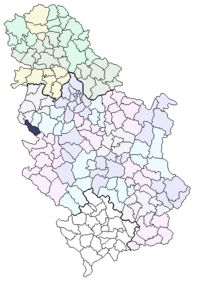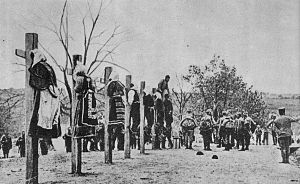Opština Ljubovija
|
Општина Љубовија Opština Ljubovija Municipality of Ljubovija |
|||||
|
|||||

|
|||||
| Part of the country | Central Serbia | ||||
| Okrug | Okrug Mačva | ||||
| Administrative headquarters | Lyubovija | ||||
| surface | 356 km² | ||||
| Residents | 17.052 | ||||
| Population density | 48 inhabitants per km² | ||||
| License Plate | LO | ||||
| Website | www.ljubovija.rs | ||||
The Opština Ljubovija ( Cyrillic : Општина Љубовија, German : Municipality Ljubovija ) is a municipality (Serbian Opština) in the Okrug Mačva in western Serbia . The administrative capital is the city of the same name Ljubovija in the west of the municipality.
geography
The municipality of Ljubovija is a border municipality between Serbia and Bosnia and Herzegovina . The Drina , a right tributary of the Save, flows through the municipality . Many smaller rivers also flow through the municipality, for example the Ljuboviđa and Trešnjica . The municipality includes the historical region of Azbukovica . The area is 356 km².
The terrain is mountainous and borders on Bosnia and Herzegovina with the Drina . The largest mountain in the Opština is Tornička Bobija . The Drina River separates the Azbukovica region from the Bosnian communities Srebrenica and Bratunac over a length of 38 km.
Since 2001 sailing regattas have been held on the Drina, which leads from Rogačica to Ljubovija. The regatta is 40 km and takes around nine hours. Up to 20,000 spectators follow the 2,000 regattas, which meanwhile form an important tourist destination in the municipality.
In the northwest is the Opština Mali Zvornik , in the north the Opština Krupanj , in the northeast the Opština Osečina , in the east the Opština Valjevo and in the south the Opština Bajina Bašta .
Places in the community
history
The earliest traces of human settlement date back to the early Stone Age . At the end of the Neolithic there were already three mines in the area of today's municipality. In addition, burial mounds in the village of Lonjin and several fortified villages in the village of Rujevac were found .
The Romans settled the region 2000 years ago. At that time the region belonged to the province of Dalmatia . Roads leading from Domavia ( Srebrenica ) to Singidunum ( Belgrade ) ran through the community . The Romans built forts to protect the roads through the Drina Valley, the most famous of which are Đurim , Nemić , Gradac and Kulina-Mikuljak . The Romans exploited mines in the area of today's Crnča and sent their income to Domavia / Srebrenica for further processing. Remains of former settlements have been found in Vrhpolje, Crnča and Uzovnica. Remains of a basilica from the 4th century have been discovered in the village of Gračanica . The remains of the Romans can be found everywhere in Azbukovica , as well as in the Folk Museum in Šabac , because Ljubovija does not have its own museum.
In the 6th and 7th centuries, Slavs settled in the municipality.
In the Middle Ages , the region belonged alternately to the Kingdom of the Nemanjids and the Byzantine Empire . At that time the Lipnik and Veliki Majdan mines were in operation. The Lipnik mine already existed in 1319.
The river Ljuboviđa in the village of Gornja Ljuboviđa is spanned by a medieval bridge that was on the way of the caravans to Valjevo and Belgrade . It is also known by the people as Latinska ćuprija . In the village of Gornja Trešnjica remains of a smaller and larger settlement from this era have been found. Other sites are in the villages of Uzovnica, Rujevac, Crnča and Gornja Trešnjica.
The Ottomans conquered the area in 1459 after the fall of Smederevo and the conquest of the entire Serbian despotate. Because of the importance of the mines near Crnča, the entire area became an imperial has, the Has Bukovica . Has Bukovica is derived from the largest village at the time, Bukovica, and the name of the Azbukovica region is said to be derived from it. The Ottomans fortified and settled the medieval fortress Soko grad (falcon town), this fortress was not to be conquered until 1862. It was not until 1834 that the Azbukovica region should be liberated from the Ottomans. And when the Turks left the Soko grad fortress in 1862 , the area became the border municipality of Serbia. The fortress was destroyed, but the remains are still standing today.
During the First World War , many inhabitants of the region died as a result of reprisals and massacres of the civilian population by the Austrians, especially women, children and the elderly fell victim to these crimes. Before these massacres, the great battles of Cer and the Drina between the Austrians and Serbs took place near the area near Krupanj and Loznica . The Mačkov Ossuary Monument on Mount Jagodnja near Ljubovija contains the bones of Serbian soldiers who died in the Drina. Most of the villages around Ljubovija expected the end of the war in 1918 with half the male and a quarter of the female population.
During the Second World War , parts of the population joined both the communist partisans and the Serbian nationalist Chetniks .
population
The majority of the population are Serbian Orthodox Serbs . The largest minority are the 166 Roma in the community.
From the 2002 census, around 17,000 people lived in the municipality of Ljubovija, while in 1961 it was around 25,000. The city of Ljubovija, on the other hand, has grown in number. The majority of those who left the municipality moved to the Mačva region , some also to the Srem and the cities of Valjevo , Novi Sad and Belgrade .
The largest settlement in the municipality is the municipality's administrative center, the small town of Ljubovija, with around 4,200 inhabitants. There are 26 villages in addition to the small town, of which Crnča and Vrhpolje are the largest.
religion
There are three Serbian Orthodox monasteries in the municipality of Ljubovija , the monastery of St. Nikolaj Srpski , which is dedicated to St. Nikolay Velimirović , near the Soko grad fortress, the Trinity monastery near the hamlet of Bijele Vode and the Trinity monastery near Čitluk.
An old wooden church can be found in Donja Orovica . There is another church on the Bobije hill . In Ljubovija itself there is the Serbian Orthodox Transfiguration Church from 1932. Other Serbian Orthodox church buildings can be seen in the villages of Selenac , Uzovnica , Vrhpolje , Gornja Trešnjica , Orovička Planina and Rujevac .
Personalities
The oldest famous person in the field of Azbukovica is the doctor Petar Protić Sokoljanin who was one of the first doctors with internationally recognized doctorates. He made his doctorate in Heidelberg in 1854 . He was also a poet for the Serbian youth organization Družine mladeži srpske . The chess legend Svetozar Gligorić comes from Donja Orovica . And from Drlače , the actor Nenad Nenadović . The poet and writer Slaviša Pavlović and the former football player and football official Miroslav Stević come from the municipal capital Ljubovija .
swell
Individual evidence
- ^ Max Hastings: Catastrophe 1914. Europe Goes to War. Knopf Doubleday Publishing Group, 2013, ISBN 9780385351225 , p. 226.
- ↑ Herbert Lackner : "Literally chopped up." In: Profil 44 (2014) of October 27, 2014.
- ^ Anton Holzer: With all means In: Die Presse from September 19, 2008.


